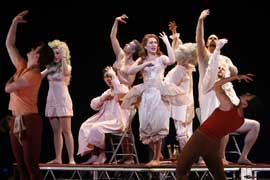
Jack Anderson
King Arthur: Amiable, Although Invisible
 |
| Cast of King Arthur: Sarah Jane McMahon, Daniel Mobbs, Iestyn Davies, Mhairi Lawson, Alexander Tall, Steven Sanders, Heidi Stober and Mark Morris Dance Group. Photo by Carol Rosegg. |
"King Arthur"
New York City Opera and
Mark Morris Dance Group
March 5-15, 2008 (closed)
New York State Theater, Lincoln Center
Reviewed by Jack Anderson, March 18, 2008
King Arthur is the principal character of "King Arthur," the
so-called "semi-opera" that John Dryden and Henry Purcell created
in 1691. But even though Purcell composed ravishing music for it, Arthur
never sings a note. Nor do other major characters. This semi-opera is
a strange Baroque hybrid: a play in which the drama is spoken and the
music is reserved for interludes. Because Mark Morris decided he disliked
the drama, he jettisoned both plot and dialogue in his production for
the New York City Opera and his Mark Morris Dance Group, thereby making
an odd work odder. What's left is "King Arthur" without King
Arthur, a plotless entertainment balletomanes might call a divertissement
and theater lovers might consider a revue.
A few words should be said defending poor Dryden, whose "King Arthur" depicts power struggles between two kings, the heroic Arthur and the sinister Oswald, and their rival magician advisers. Both monarchs love the beautiful blind Emmeline, and some of Dryden's most fascinating speeches ponder how other senses may compensate for the lack of sight. Conceivably, an imaginative stage director might be intrigued by Dryden's drama. But Dryden didn't interest Morris, so out went Dryden's lines. Curiously, in the Playbill, Morris speaks of Dryden writing in "boring rhymed couplets." Yet, although the song texts Morris retained are rhymed, the play itself is in blank verse: i.e., unrhymed iambic pentameter. So here's a "King Arthur" without King Arthur, although Morris does make his regal presence implicit by placing a crown on stage in certain scenes.
Morris's alterations have horrified some viewers. Yet, bored by Dryden but infatuated with Purcell, Morris has never disguised his intentions, and what he gives us is a long musical and choreographic suite, well conducted by Jane Glover. Perhaps if Morris had staged his production to a recording of the vocal and instrumental music, as impecunious choreographers usually do when inspired by scores requiring musical forces beyond their means, there would have been less uproar, since choreographers abridge or rearrange music all the time.
Morris's basic theatrical conceit is to make his staging suggest a show put on by singers and dancers of an opera house who have been rummaging through their theater's scene shops and wardrobe closets. But since Adrianne Lobel provided the scenery and the costumes are by Isaac Mizrahi, these are stylish odds and ends.
Scenes crystallize and melt, according to Purcell's musical moods and Morris's choreographic caprices. Some incidents underscore the notion that this production is a show assembled from bits and pieces: for instance, a sacrificial processional with sawhorses as beasts.
Several episodes are whimsical. Will-o'-the-wisps and elves dash in and out of mirrored closets like characters in a French farce. A man emerges from a refrigerator during a musical portrait of winter. A parade with performers in animal masks appears intentionally pointless, but deliberately cute. Morris, over the years, has occasionally fancied outrageous effects. Here, he restrains his tendencies toward excess. Although I failed to see the point of folding laundry to patriotic praises of Britain, the action puzzled rather than shocked me. And a song extending an invitation to bathe naked prompted liquid motions, as might be expected, yet the performers stayed clothed.
In his ensembles, Morris often sent dancers lightly skipping through formations resembling those of folk dances with many changes of partners. The most ambitious of these was a complex, but never forced-looking, Maypole dance in which merrymakers kept going forward and reversing themselves in intricate patterns.
If anything, Morris's dances were too mild, producing an
overall sense of sameness, even when the music was fantastically varied.
Nevertheless, although seldom memorable and never eloquent, the action
was pleasant to watch and undeniably diverting. And Morris did intend
his "King Arthur" to be a divertissement.
| museums | NYTW mail | recordings | coupons | publications | classified |
